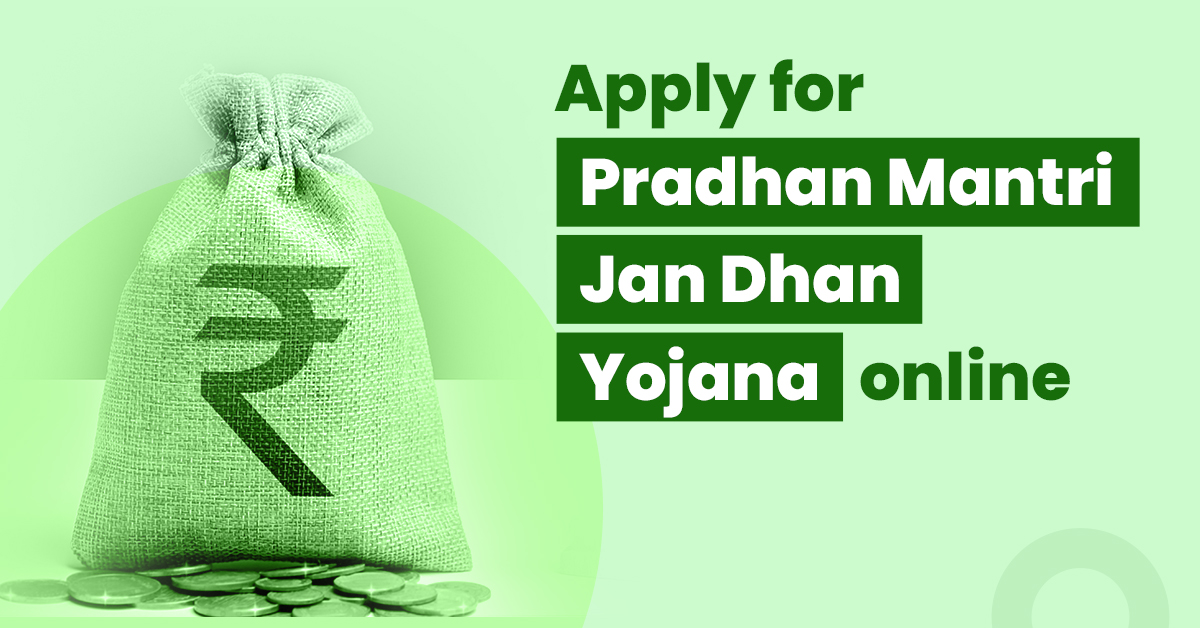How To Apply For Pradhan Mantri Jan Dhan Yojana Online?


The Pradhan Mantri Jan Dhan Yojana (PMJDY) is a government-backed scheme launched to promote financial inclusion. Prime Minister Narendra Modi introduced this scheme in 2014.
The scheme’s primary objective is to bring all households under the purview of financial services. It allows citizens from underprivileged sections of society easy access to benefits like credit, remittance, pension, insurance, savings, and deposit.
Under this scheme, anyone without a bank account can open a savings bank deposit account (BSBD) at a bank or Bank Mitra outlet. There is also no requirement to maintain a minimum balance, and you can open a zero-balance account.
Read on to learn more about Pradhan Mantri Jan Dhan Yojana’s online application procedure, the eligibility criteria and more!
How to Open a PMJDY Account
Applying for the Pradhan Mantri Jan Dhan Yojana is simple. All you need to do is submit the PMJDY application form, the eligibility proof, and your KYC documents.
To apply successfully, you must fulfil the following criteria:
- You must be an Indian citizen.
- Your age should be at least ten years or more.
- You should not have a bank account.
If you meet the eligibility norms, follow the steps below to initiate the account opening process. You can go for the Jan Dhan Yojana online apply option or visit the bank physically to submit your documents.
- Download the PMJDY form from Pradhan Mantri Jan Dhan Yojana website. Alternatively, you may collect it from the nearby bank branch.
- Submit the form and supporting documents to open the Jan Dhan Yojana account. You have to visit the bank branch and submit the required documents. Complete the KYC form and submit it for verification.
- After the verification, your PMJDY account will be activated.
Also Read: Best High Risk Mutual Funds to Invest in 2023
Documents Required to Open an Account for PMJDY Scheme
You will require the following documents to open a PMJDY account.
- If you have an Aadhaar number or card, you do not need to submit any other documents. However, if your Aadhar card is not updated with your current address, then a self-certification of your current address is acceptable.
- If you do not have an Aadhaar card, you can present any one of the officially valid documents (OVD) that prove your identity and address.
| Document Type | Is it a valid identity/address proof? |
| Driving licence | Yes |
| Voter ID card | Yes |
| Passport | Yes |
| Job card by NREGA signed by a state government officer | Yes |
| Letter issued by national population registry that validates name and address | Yes |
- If you are categorised as a low-risk customer by the bank and do not hold a valid Aadhar card, you can submit one of the foll :
- An ID card with a photo issued by a central/state government department, statutory/regulatory authorities, public sector undertakings, scheduled commercial banks, or public financial institutions.
- A letter from a gazette officer and an attested photo of the applicant.
Note: Reserve Bank of India (RBI), vide its Press Release dated 26.08.2014, has further clarified that those persons who do not have any of the ‘officially valid documents’ can open “Small Accounts” with banks on the basis of a self-attested photograph and signature/thumb impression.
Also Read: How to Deposit Money in Sukanya Samriddhi Account Online?
Benefits of PMJDY
The Pradhan Mantri Jan Dhan yojana offers the following benefits.
- Accident Insurance:
The scheme provides Accident Insurance worth Rs.1 lakh. However, it is revised to 2 lakh for the PMJDY accounts opened after 28-08-2018.
A claim under personal accidental insurance for PMJDY will be payable only if the RuPay cardholder has performed a successful RuPay card-related financial transaction within 90 days preceding the accident. - Easy banking with RuPay debit card:
Under PMJDY, you will receive a RuPay debit card free of charge. You can use the card at ATMs, online merchants, and point-of-sale machines. - Interest rate:
Like all savings schemes, you can earn interest on your deposits. However, it must be remembered that the PMJDY will be subject to the interest rate of a savings bank account. - Government program beneficiaries:
Government program beneficiaries will receive direct payments in their Jan Dhan accounts. - Overdraft:
You may obtain an overdraft of up to Rs 10,000. However, this only applies to one account per household. Accounts are eligible for overdraft after a satisfactory operation for six months. - Money transfer:
You can transfer funds at any time using your PMJD account. - Zero balance facility:
You do not need to deposit a minimum amount or maintain a minimum balance. However, if you wish to get a cheque book, you will need to fulfil the minimum balance criteria, if any, of the bank. - Financial inclusion:
Pradhan Mantri Jan Dhan Yojana provides financial services to rural communities and underprivileged people, bringing them into the fold of banking services. - Access to various Government schemes:
As a PMJDY account holder, you are eligible for the following government schemes:
– Atal Pension Yojana.
– Pradhan Mantri Jeevan Jyoti Bima Yojana.
– Micro Units Development & Refinance Agency Bank scheme.
– Pradhan Mantri Suraksha Bima Yojana.
– Direct Benefit Transfer (DBT)
- Online application process
You can apply for the PM Jan Dhan Yojana online without hassles. This saves you the hassle of waiting in long queues at the bank.
Read More: What is Pradhan Mantri Jan Dhan Yojana?
Final Thoughts
The zero balance savings account under the PMJDY program is a great way to integrate a large segment of the population into mainstream financial services, thus also empowering them with financial knowledge.
The procedure to open a PMJDY account is simple. You can either choose the Pradhan Mantri Jan Dhan Yojana online apply option or visit a bank to complete the process in minimum steps.
This scheme has benefitted many rural and underprivileged populations by offering them modern banking facilities like debit cards, overdraft facilities, pensions, and insurance plans.
FAQs about PMJDY
What is accidental coverage in PMJDY?
Before 28-8-2018, PMJDY offered accident insurance of Rs.1 lakh. However, the cover has been increased to Rs.2 lakh for accounts opened after 28-8-2018.
Under PMJDY, the claim will be payable only if the RuPay cardholder has performed a successful RuPay card transaction 90 days before the accident.
Who is eligible for the PMJDY account?
The following are the eligibility criteria:
1. You must be an Indian citizen.
2. Your age should be at least ten years or more.
3. You should not have a bank account.
What minimum amount must I deposit to open a Jan Dhan account?
Jan Dhan accounts do not require an initial deposit. They can be opened with zero balances and do not require you to maintain a minimum balance.
What is the procedure for Jan Dhan account opening online?
The process is straightforward. All you need to do is download the application form from https://pmjdy.gov.in/. After this, please fill out the form and submit it with supporting documents. The bank will carry out a KYC verification. Once verified successfully, you will be allotted a bank account.
What documents do I require to open an account under Pradhan Mantri JanDhan Yojana?
If you have an Aadhaar number or card, you do not need to submit any other documents.
If you do not have an aadhaar card, you can present any one of the officially valid documents (OVD) that prove your identity and address.
Does PMJDY offer overdraft facilities?
Overdrafts of up to Rs.10,000 are available to PMJDY account holders. However, this only applies to one account per household. Accounts are eligible for overdraft six months after it was opened.
What are the features of the Jan Dhan bank account?
The following are the features of PMJDY:
> Interest on deposit.
> Rupay debit card.
> Accidental insurance cover.
> Zero balance account.
> Government program beneficiaries will receive direct payments in their Jan Dhan accounts.
> Overdraft facility.
> Access to Pension and insurance products.
How to open a Jan Dhan account if I have no documents?
You can submit an ID card with a photo issued by a central/state government department, statutory/regulatory authorities, public sector undertakings, scheduled commercial banks, or public financial institutions. If you do not have ‘officially valid documents’ or an Aadhaar card, you can still open an account provided you are categorised as a low-risk customer by the banks.



